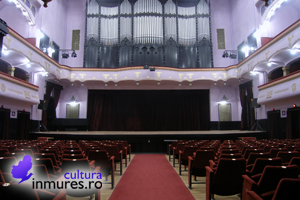
State Philharmonic
The institutionalization of musical activity occurred in Tîrgu-Mureș at the turn of the 20th century. In 1874 an association of music lovers and a choral circle came into being. An amateur orchestra conducted by Vegler Gyula, as well as chamber orchestras, quartets and quintets were established in this period. Symphonic and coral concerts were organized periodically, featuring musicians from Tîrgu-Mureș, as well as guests from other cities or from abroad. In 1908, a music school was established under the management of conductor and composer Albert Metz. The school was officially opened during the mayorship of Bernády György who had a deep understanding of the role of culture in a community and supported cultural activities. The school functioned in an inappropriate building for a few years, then moved to the newly-built Palace of Culture in 1913. The design of the building provided for a large concert hall with an organ built by the Rieger factory. Albert Metz established a professional symphonic orchestra of music school teachers. An important step toward the enrichment of local musical culture were the performances of great European classical musicians such as Pablo Casals, Bartók Béla, Joseph Szigeti etc. In 1922, the Music School of Tîrgu-Mureș was granted the status of superior education institution and was entitled Municipal Conservatory. In 1925, after the death of Albert Metz, Maximilian Costin, a violinist educated in Paris and Berlin, a professor at the Conservatory of Bucharest and manager of the Conservatory of Timisoara, was appointed head of the Municipal Conservatory. Among the faculty members were remarkable professors such as Zeno Vancea, Elsa Goering, Ioan Petrescu, George Ionescu, Olga Vancea-Costin. Many nationally and world-renowned musicians such as Constantin Silvestri, Aca de Barbu, Alexandru Demetriad, Maria Samson were students of the Municipal Conservatory. George Enescu's close ties to Tîrgu-Mureș are also proof of the vividness and dynamism of the town”™s musical life. He performed in seven concerts for the public of Tîrgu-Mureș during the inter-war era. He had a special fondness for the Conservatory of Tîrgu-Mureș stating that: “it is one of a kind in this country”. In 1939 Enescu was granted the title of citizen of honour and a yearly performance contest bearing his name was initiated for the students of the Conservatory. After the Second World War and the educational reform of 1948, the musical school of Tirgu Mures was re-organized. In 1949, the Conservatory ceased to exist and was replaced by the music section of the Arts Highschool. Its first manager was Géza Kozma, a composer and cellist. In 1950 the orchestra was granted the status of State Philharmonic and it had 40 members, the number of which would double until 1958. In 1967 the Chamber Music Orchestra was established, and in 1970 the Mixt Choir came into being, which allowed for the repertoire to enrich and diversify. The personalities who left their mark on the evolution of the Tîrgu-Mureș Philharmonic were conductors Remus Georgescu and Szalman Lorand and composer Csiky Boldizsar, as musical secretary. Nowadays the philharmonic performs symphonic, chamber, vocal-symphonic and educational concerts on a weekly basis. Its activity is crowned by three annual festivals: Zilele muzicale târgumureșene (Musical Days of Tîrgu-Mureș , Festivalul internațional Constantin Silvestri (The International “Constantin Silvestri” Festival) and Musica Sacra. The orchestra”™s permanent conductor is Shinya Ozaki, of Japanese origin, and the conductor of the choir is Vasile Cazan who is also manager of the institution.
Bibliography:
Csiky Boldizsár, Privire asupra trecutului muzical tîrgumureșean in vol. "Tîrgu-Mureș, oraș al artelor", published by the Tîrgu-Mureș City Hall in cooperation with the "Vatra" review, pp. 279-292.
Traian Dușa, Învățământul muzical la Tîrgu-Mureș în prima jumătate a secolului al XX-lea in "Pagini de istorie, artă și cultură" vol. I, Ed. Ansid, Tîrgu-Mureș, 2002
Traian Dușa, Filarmonica de Stat în "Pagini de istorie, artă și cultură" vol. II, Editura Ansid, Tîrgu-Mureș, 2002, pp. 125-141.

